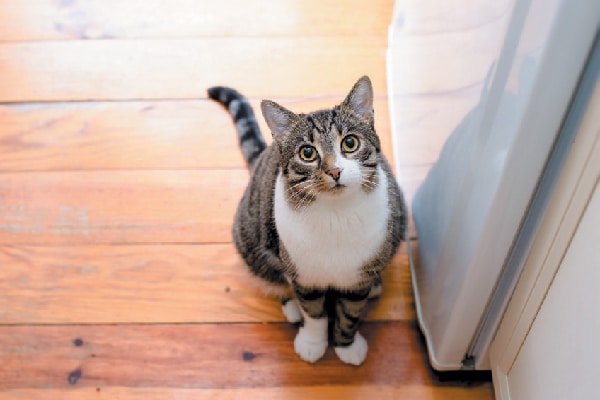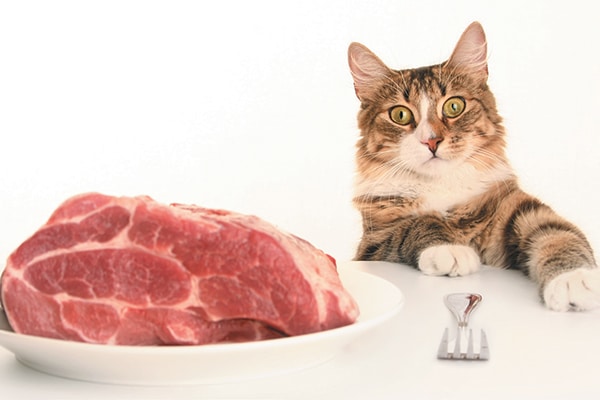When selecting what you hope is a nutritionally fortified food choice for your cat, it’s easy to be afflicted with a case of the Double C’s — Confusion and Concern. Confusion occurs due to the eruption of choices available online and on store shelves, and concern that you are indeed picking one containing healthy nutrients your cat needs. Should you stick with traditional commercial “cooked” diets that come in kibble and canned forms or venture into the world of raw food diets? Nowadays, a raw food diet for cats could run the gamut from uncooked, fresh meats you prepare at home to dehydrated ones you add water to, pre-packaged frozen meals and freeze-dried versions.
“Today, pet parents have more healthy diet options to pick from than ever,” notes Jennifer Coates, DVM, a veterinarian and author based in Fort Collins, Colorado. “Cats tend to do well on a diet that is high in protein, contains adequate amounts of water and is made primarily from ingredients that sound like ‘real’ food. A veterinarian familiar with a cat’s particular needs is in the best position to make specific recommendations.”
A Raw Food Diet for Cats — Yes or No?

What are the pros and cons of a raw food diet for cats? And will your cat accept this new cuisine, or sniff and walk out of the kitchen? For answers, Catster turned to our experts, Dr. Coates as well as Katherine Evans, DVM, a veterinarian at the Holistic Veterinary Center in Concord, New Hampshire, and Ihor Basko, DVM, a veterinarian at All Creatures Great & Small in Kapaa, Hawaii.
A Raw Food Diet for Cats — The Pros
1. More quality commercially prepared raw diets are now available. Dr. Evans says, “Commercial raw diets are generally easier to feed than home-prepared diets, and they tend to contain more organ meat so the cats get all the different amino acids they need.”
2. Commercial raw diets tend not to include carbohydrates. These diets tend to include ingredients designed for what your cat is — a meat-eating carnivore. Our experts noted that carbohydrates are complex sugars, and foods containing these might contribute to urinary issues and diabetes in some cats. Dr. Basko says, “Dry food can create crystals in a cat’s bladder, causing urinary tract infections and plugged urethras in male cats.”
3. Some cats with health issues fare better on commercial raw diets as recommended by their veterinarians. “Diets containing single proteins like some freeze-dried commercial raw diets are good for cats with food sensitivities,” Dr. Evans notes. “I’ve noticed that cats tend to like freeze-dried rather than frozen raw food diets. It is important to add warm water to these freeze-dried diets to make the protein closer to the body temperature of a mouse — around 102 degrees Fahrenheit. This makes it more appealing to cats. Remember that cats are very picky, but their pickiness has evolved with their survival.”
A Raw Food Diet for Cats — The Cons
1. Some cats are neophobic — they have a fear of the new. “It’s great to have a cat who eats anything, but that is not common,” Dr. Evans says. “Cats develop strict preferences for the shape, texture and smell of specific foods as kittens. That is why it is important to expose them to a variety of healthy foods when they are kittens.” Dr. Basko adds, “Cats addicted to dry food have a hard time switching to raw.”
2. Preparing homemade raw diets can be time-consuming and risky. “Home- cooked diets are great for sick pets, pets recovering from surgery and pets with allergies and gastrointestinal problems, but they take time, and a raw food diet prepared from beef, lamb or rabbit may not contain enough taurine, an essential amino acid necessary for proper heart function,” Dr. Evans says. Dr. Coates says, “Some commercially available raw food diets are being recalled for contaminants like Salmonella and Listeria at a greater rate than are commercially available ‘cooked’ diets. If pet parents choose to buy these foods, they should use the same food hygiene practices that they would when handling something like raw chicken (wash hands thoroughly after handling, disinfect surfaces) and only offer them to healthy, adult cats who are not immunocompromised in any way.”
Dr. Basko points out, “Cats on steroids and many drugs might be more susceptible to picking up parasites from raw meat (toxoplasmosis) and pathogenic bacteria.”
3. Commercial raw diets tend to cost more than commercial dry and canned food. “I recommend buying human-grade, USDA-approved, antibiotic-free organic food if you can afford it,” Dr. Basko says.
Adds Dr. Evans, “Pet foods have gotten extraordinarily expensive. To me, canned food is a better option, as you are not looking at breaking the bank as you would with freeze-dried raw foods.”
The Final Word on a Raw Food Diet for Cats
The American Veterinary Medical Association has gone on record opposing feeding raw diets to cats and dogs. The group’s main concern is the risk that raw or undercooked animal-sourced protein like chicken may be contaminated with bacteria that will make the pet ill or infected.
But Dr. Evans sees more public interest in commercial raw diets.
“There is a greater awareness by educated consumers to put more pressure on companies for better quality products,” she says. If you are considering the raw food route — making homemade meals or purchasing commercially prepared ones, Dr. Coates offers this final piece of advice: “I recommend that any homemade diet, cooked or raw, be prepared based on a recipe that is put together by a veterinary nutritionist.” Two raw food diet websites managed by veterinarian nutritionists include balanceit.com and petdiets.com.
Arden Moore is a pet behavior consultant, author and master pet first-aid instructor who often teaches hands-on classes with her cool cat, Casey, and very tolerant dog, Kona. Each week, she hosts the Oh Behave Show on Pet Life Radio. Learn more at ardenmoore.com, and follow Arden on Twitter at @ArdenKnowsPets.
Editor’s note: This article originally appeared in Catster magazine. Have you seen the new Catster print magazine in stores? Or in the waiting area of your vet’s office? Click here to subscribe to Catster and get the bimonthly magazine delivered to your home.
Thumbnail: ©PumpizoldA | Getty Images.








